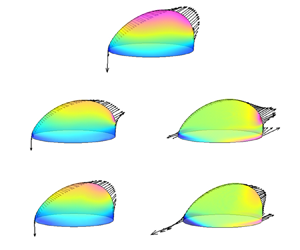Article contents
Viscoelastic effects on the deformation and breakup of a droplet on a solid wall in Couette flow
Published online by Cambridge University Press: 16 May 2023
Abstract

The deformation, movement and breakup of a wall-attached droplet subject to Couette flow are systematically investigated using an enhanced lattice Boltzmann colour-gradient model, which accounts for not only the viscoelasticity (described by the Oldroyd-B constitutive equation) of either droplet (V/N) or matrix fluid (N/V) but also the surface wettability. We first focus on the steady-state deformation of a sliding droplet for varying values of capillary number ( $Ca$), Weissenberg number (
$Ca$), Weissenberg number ( $Wi$) and solvent viscosity ratio (
$Wi$) and solvent viscosity ratio ( $\beta$). Results show that the relative wetting area
$\beta$). Results show that the relative wetting area  $A_r$ in the N/V system is increased by either increasing
$A_r$ in the N/V system is increased by either increasing  $Ca$, or by increasing
$Ca$, or by increasing  $Wi$ or decreasing
$Wi$ or decreasing  $\beta$, where the former is attributed to the increased viscous force and the latter to the enhanced elastic effects. In the V/N system, however,
$\beta$, where the former is attributed to the increased viscous force and the latter to the enhanced elastic effects. In the V/N system, however,  $A_r$ is restrained by the droplet elasticity, especially at higher
$A_r$ is restrained by the droplet elasticity, especially at higher  $Wi$ or lower
$Wi$ or lower  $\beta$, and the inhibiting effect strengthens with an increase of
$\beta$, and the inhibiting effect strengthens with an increase of  $Ca$. Decreasing
$Ca$. Decreasing  $\beta$ always reduces droplet deformation when either fluid is viscoelastic. The steady-state droplet motion is quantified by the contact-line capillary number
$\beta$ always reduces droplet deformation when either fluid is viscoelastic. The steady-state droplet motion is quantified by the contact-line capillary number  $Ca_{cl}$, and a force balance is established to successfully predict the variations of
$Ca_{cl}$, and a force balance is established to successfully predict the variations of  $Ca_{cl}/Ca$ with
$Ca_{cl}/Ca$ with  $\beta$ for each two-phase viscosity ratio in both N/V and V/N systems. The droplet breakup is then studied for varying
$\beta$ for each two-phase viscosity ratio in both N/V and V/N systems. The droplet breakup is then studied for varying  $Wi$. The critical capillary number of droplet breakup monotonically increases with
$Wi$. The critical capillary number of droplet breakup monotonically increases with  $Wi$ in the N/V system, while it first increases, then decreases and finally reaches a plateau in the V/N system.
$Wi$ in the N/V system, while it first increases, then decreases and finally reaches a plateau in the V/N system.
- Type
- JFM Papers
- Information
- Copyright
- © The Author(s), 2023. Published by Cambridge University Press
References
- 7
- Cited by



